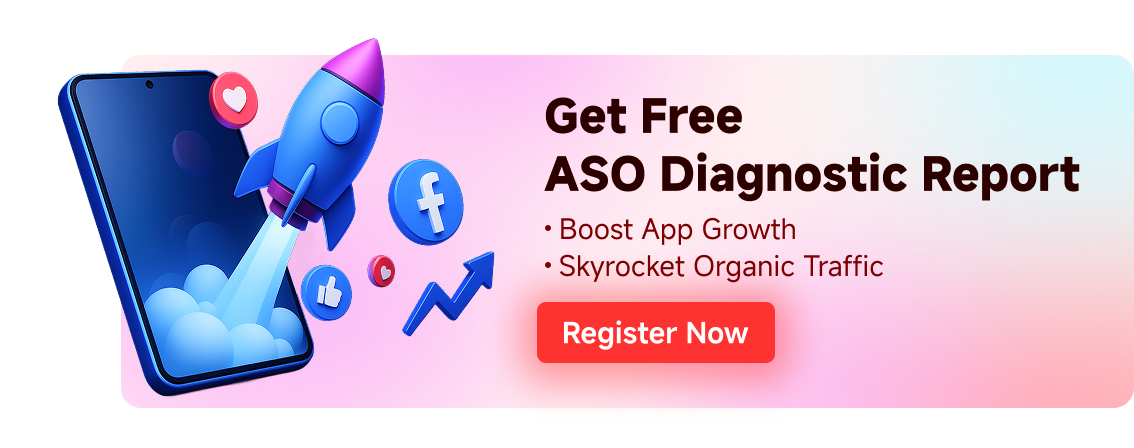Free consultation with ASO specialists
Doing ASO for the first time or have no idea how to carry out targeted optimization of your app?
We offer one-on-one customized services provided by app marketing specialists
APP iteration after the ranking decline? Optimize ASO to maintain application visibility
2025-07-24
Introduction
In the competitive app market, App Store Optimization (ASO) is a core strategy for improving app visibility and downloads. As the primary channel for users to discover new apps, Apple's App Store data shows that more than 65% of downloads come from user-initiated searches, and its homepage can attract hundreds of millions of visits each week. Therefore, an app's ranking in search results and rankings directly determines its potential for organic growth.
However, many developers often face a tricky problem after completing version updates or feature iterations: the decline in app rankings. Although this phenomenon is common, it significantly impacts the app's traffic and download performance.What is the fundamental reason for the ranking decline after APP iteration?How to quickly recover and continuously improve app visibility through ASO optimization? This article will deeply analyze the common causes of ranking decline, and provide practical ASO optimization strategies to help developers effectively maintain or even improve rankings after app updates.
APPCommon reasons for ranking decline after iteration
The changes in app rankings are affected by many factors, and they are particularly sensitive after the APP update. Understanding the common causes of app ranking decline is the key for developers to optimize ASO and adjust strategies in time. Here are several core reasons for ranking decline after iteration:
App Store Algorithm Changes (Affecting Keyword Rankings)
One of the core challenges of App Store Optimization (ASO) is the continuous updates to app store algorithms (especially Apple App Store and Google Play). These algorithm adjustments are intended to improve user experience, but often occur without warning and may change multiple times within a year. If an app's ASO strategy fails to keep up with new rules, keyword rankings may significantly decline.
Developer's golden rule:
-
Dynamic Monitoring: Subscribe to Apple/Google Official Developer Announcements
-
Impact Assessment: Algorithm Update 72 Hours to Use UPUP Diagnostics for Ranking Fluctuations
-
Quick response: Targeted adjustment of metadata combination (such as adding screenshot keywords)
Metadata update improperly (harming app visibility)
App Store rankings are extremely sensitive to metadata changes (title, subtitle, keyword fields, description, etc.). Improper metadata updates during iterative releases can easily cause ranking fluctuations. Any modification to the title, subtitle, or keyword fields may continue to affect rankings for up to 4 weeks after release. For example:
-
Keyword optimization mistakes: Replacing a large number of keywords or significantly modifying the title may cause the app to lack relevance on new words, while losing its original ranking advantage.
-
Too frequent updates: Each metadata update will trigger the store to re-crawl and index. New keywords usually take 14-25 days to reach full ranking potential. If you frequently change them before old words have stabilized, it will interfere with algorithm evaluation, causing the app's visibility to continue to decline.
Therefore, when updating metadata during iteration, be cautious: choose the timing of version update synchronization, make small adjustments, and reserve sufficient observation period (at least 2-3 weeks) to avoid excessive changes at one time. The following figure isApple's official advice on releasing version updates.
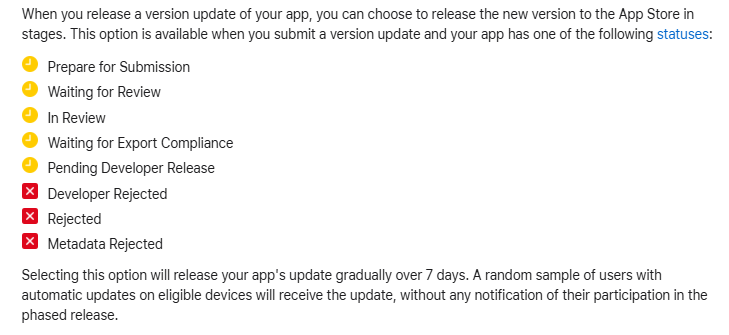
Competitor Strategy Change
The app market is in a state of dynamic competition. When you are iterating your app, your competitors may be optimizing ASO or increasing promotion efforts, which will affect your search ranking. For example:
-
Competitor updates metadata or launches new features, boosting relevant keywords and causing them to surpass your rankings on specific search terms.
-
New apps entering: Apple and other platforms often give new apps an initial ranking boost (such as in the "new" category). A strong new competitor may temporarily suppress your position on some keywords.
Therefore, during the iteration, it is necessary to closely monitor the keyword changes and ranking trends of competitors through ASO tools, and adjust your own strategy in a timely manner to maintain competitiveness.
User Feedback and Ratings Volatility
User ratings and reviews are key to potential users' decision-making, and more importantly, they are important signals for app store ranking algorithms. High ratings and positive reviews can improve rankings, while negative feedback will lower rankings. After an APP iteration, if the updated content causes user dissatisfaction (such as introducing serious bugs or changing user habits), it may lead to:
-
Ratings plummet, negative reviews surge, and the algorithm consequently lowers the app's priority in search results.
-
User retention rate drops: a large number of users quickly uninstall after the update, and the platform will be regarded as a decline in application quality, thus "punishing" it on the ranking.
Therefore, after iteration, we must pay great attention to user feedback, quickly fix problems, and stabilize Ratings and Reviews through active communication management, preventing the decline of word-of-mouth from dragging down the application ranking.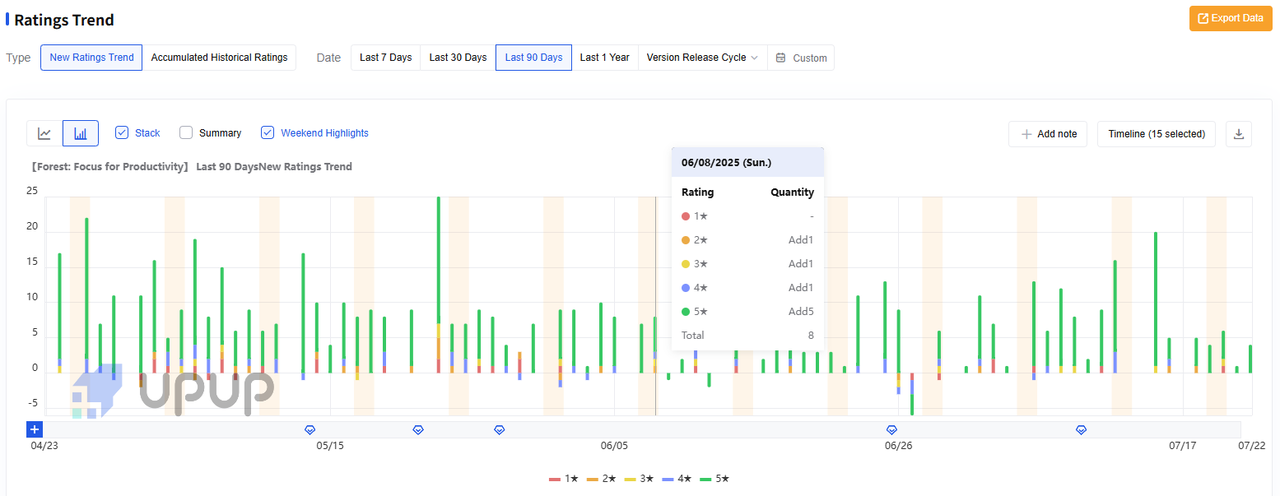

Other potential factors
In addition to the above core reasons, please note:
-
Adjusting the application category: The change of category by itself or competitors may affect the ranking of specific keywords due to differences in search weight and user groups.
-
Seasonal/periodic fluctuations: Changes in user search behavior during specific holidays or events can lead to short-term ranking fluctuations.
-
Review delays: Updates are rejected or delayed, disrupting the promotion rhythm and possibly affecting rankings.
In short, the ranking drop after iteration may be caused by a combination of multiple factors. Developers need to analyze in depth according to specific circumstances, so as to take precise ASO optimization measures.
ASO Optimization Strategies to Maintain Visibility
In response to the above reasons that may cause ranking decline, developers can stabilize and improve the visibility of their apps through systematic ASO optimization. The following will provide specific strategies and best practices from aspects such as keyword optimization, metadata update, and user feedback management.
Keyword Optimization: Keeping up with Trends and User Intent
Keyword optimization is the core of ASO, directly determining whether an app can appear in user search results. To cope with ranking fluctuations after iteration, developers should continuously optimize keyword strategies to ensure that their apps remain competitive on target keywords:
-
Continuously research and update keywords
-
User search behavior is dynamic and ASO optimization needs to keep high-frequency iteration.
-
Use professional tools (such as UPUP) regularly for keyword research, identify high-potential new words and long-tail keywords, and eliminate inefficient keywords.
-
Best practice: Set aside a fixed amount of time each week to analyze search trends, and incorporate trending keywords into metadata to maintain application relevance.
-
Focus on high-potential long-tail keywords
Popular short-tail keywords are often highly competitive, while long-tail keywords (phrases usually composed of three or more words) are less competitive and have higher conversion rates because they are more specific.
-
Short tail keywords are highly competitive, while long tail keywords have low competition, clear intent and high conversion rates.
-
Action after iteration: Expand long-tail keywords around new features, and integrate subheadings to cover segmented demands.
-
Make sure keywords are relevant to your app content
-
Algorithms crack down on clickbait: If keywords do not match the actual function, users will uninstall and give bad reviews, which will damage the app's ratings.
-
Key Strategies:
-
Review keywords for new value proposition match immediately after iteration
-
Added new keywords, removed outdated terms
-
Make sure keywords are closely related to the core user benefits, and improve algorithm trustworthiness
-
-
Establish a keyword ranking monitoring system
-
Regularly track the ranking changes of target words and respond promptly to abnormal declines (such as competition impact, algorithm updates).
-
Optimization:
-
ASO A/B test to verify the effect of new words (for example, after adding "automatic accounting" in subtitle, monitor data for 2 weeks)
-
Adjust the order or combination of keywords fields to observe changes in download volume
-
Tool recommendation: UPUP keyword tracking panel monitors ranking fluctuations in real time
-
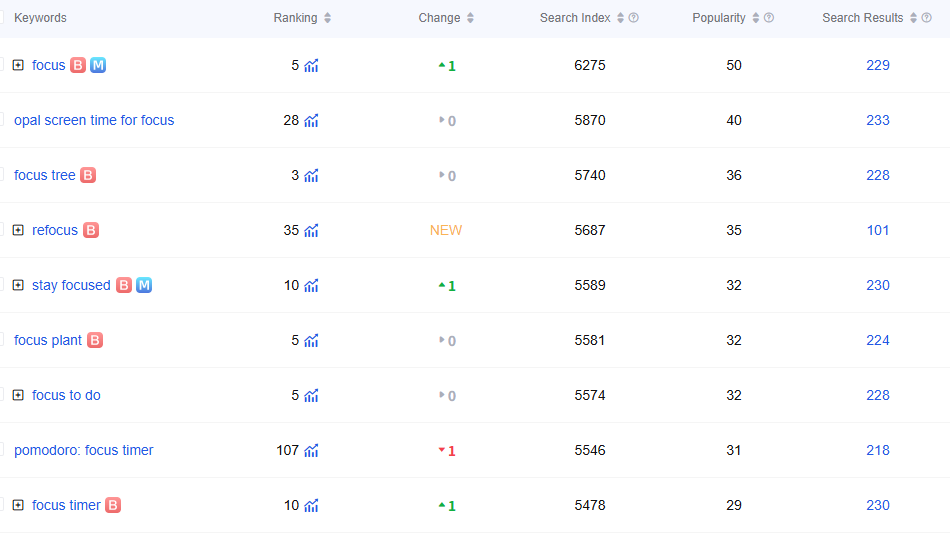
Through the above keyword optimization measures, developers can ensure that the app continues to follow user search trends after iteration, cover more potential users, and maintain or improve rankings on target keywords.
Metadata Update: Careful Optimization, Improved Relevance
The metadata of an application (including title, subtitle, keyword fields, app description, etc.) is the basis of ASO. When APP iterates, it is often necessary to update metadata synchronously to reflect new features or adjust market positioning. However, metadata updates must be strategic to avoid negative impacts on rankings:
-
Title and Subtitle Optimization
-
Core principles for title optimization:
-
Apple App Store Top Rated Field (30 characters max)
-
Must include brand name + core keyword
-
After iteration, new function keywords can be implanted in subheadings (limited to 30 characters)
-
-
Subheading Strategy:
-
Add 2-4 highly relevant keywords (naturally integrated into the product description, avoid keyword stuffing)
-
Listing keywords in a rigid manner will reduce algorithm ratings and user experience
-
-
Keyword Field Optimization
In the Apple App Store, developers can fill in up to 100 characters for Keyword Field (Use commas to separate). This is a hidden metadata area that users cannot see but will affect search matching. After iteration, check whether the keyword field needs to be updated, for example, adding keywords related to new features or replacing old words that are no longer relevant.
When filling in the keywords field, follow Apple's rules:
-
100 character keyword field (comma separated, no duplicate title/subtitle words)
-
Do not use irrelevant or inappropriate words
-
Keep keyword fields relevant and diverse
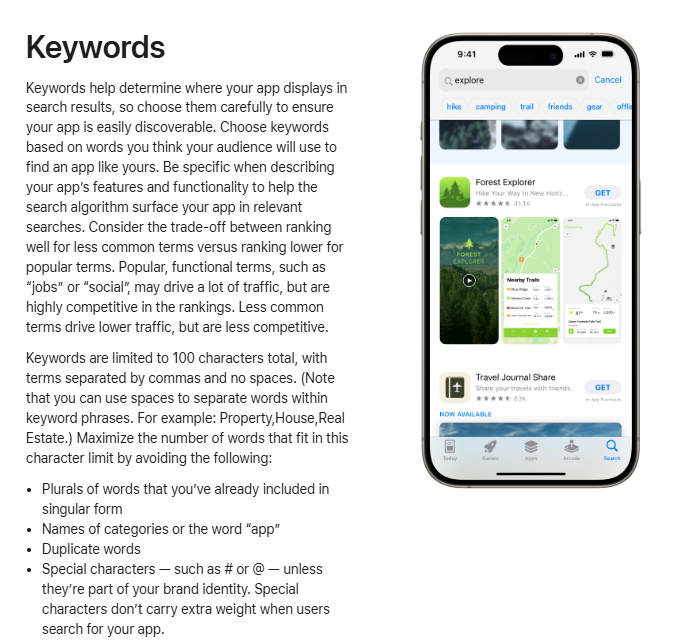
For GooglePlay, although there is no independent keyword field, Google will extract keywords from the application title and long description, so when optimizing the Play store, the core keywords should be mentioned naturally in the description (while avoiding excessive repetition leading to misjudgment of violations).
-
App Description Optimization
Detailed description is an important part of conveying the value of the application to users, and Google Play The search ranking is also critical.
-
Optimization focus after iteration:
-
The first paragraph of the application description highlights the value and improvement of new features
-
The middle section embeds long-tail keywords and questions frequently asked by users (FAQ) to improve the match with search queries
-
Technical Specification: Segmentation + Symbol List + Key Sentences in Boldface
-
-
Multilingual Market:
-
Update localised descriptions in sync (non-machine translation needs to be optimised independently)
-
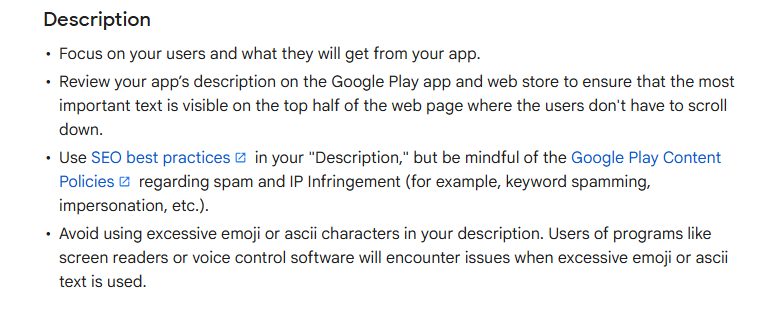
-
Update Timing and Frequency
The timing of metadata updates can have a big impact on rankings. Ideally, metadata optimization should be synchronized with app version updates.
-
Operation path: When submitting a new version of the installation package for review, update metadata such as title and description synchronously
-
Core Advantages:
-
The algorithm associates version iteration with metadata changes, accelerating new keyword indexing
-
Avoid triggering the "keywords and content mismatch" algorithm alert
-
High-risk behavior: Modify metadata separately when there is no version update
-
Potential Consequences:
-
If there is no actual function support, it may be judged by the algorithm as "semantic mismatch", which will reduce the ranking
-
Users may experience positioning bias when searching for original high-ranking keywords
-
Update frequency rule:
-
iOS metadata: Optimize once every 4-6 weeks (ASO industry golden cycle)
-
Key observation period: ≥2-3 weeks of silent monitoring after each update, new keywords need 14-25 days to reach peak ranking potential, frequent changes will interfere with algorithm evaluation
-
Monitor update effects
After each metadata update, closely monitor changes in the app's search rankings and download volume. You can use analytical tools provided by app stores (such as the Search Traffic Report in App Store Connect and Store Performance Data in Google Play Console) to see which keywords have increased or decreased exposure and click-through rates. If you find that certain keywords significantly drop in ranking after an update, you may need to roll back or adjust the relevant metadata. By optimizing metadata in small, rapid steps and data-driven ways, gradually improve the app's relevance and ranking performance.
In short, metadata updates should be timely and cautious: neither static nor abrupt. Through strategic adjustments, the app's metadata can always keep up with the latest app features and user needs, thus continuing to win favor with app store algorithms after iteration.
👉The accuracy of metadata optimization directly affects the visibility of the APP, but manually arranging keywords and balancing character limits is often time-consuming and difficult to achieve ideal results. If you need professional support in title optimization and keyword screening, please feel free to contactAppFast Customer Service, Our ASO team can provide free keyword layout and metadata deep optimization services to help you efficiently bury tag clues and make it easier for Apple's algorithm to identify core functions.
User Feedback Management: Improving Ratings and Retention
User Ratings and Reviews are the core quality signals of App Store ranking algorithms, directly affecting app visibility. After iteration, it is necessary to actively manage feedback to improve ratings and maintain user retention. Specific strategies are as follows:
-
Encourage positive Ratings
-
-
When users complete an achievement (such as meeting a fitness goal)
-
When the 5th consecutive active start
-
After clearly expressing satisfaction (such as clicking "Like this feature")
-
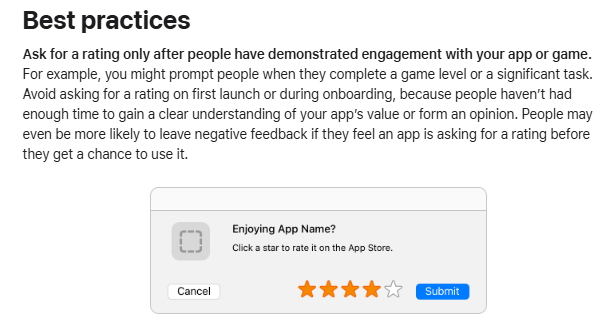
-
Technical Compliance Points:
-
Apple SKStoreReviewController(Up to 3 pop-ups per year)
-
The Android In-App Review API has no limit on the number of times it can be called, but whether or not users see the dialog depends on Google Play's quota rules.
-
-
Passive Entry Supplement:
-
The "Go to Ratings" button is always present on the settings page (conversion rate about 12%)
-
⚠️ Avoid frequent interruptions: Only prompt 1 time within 30 days for the same user
-
Reply to user Reviews
Developers should respond to both positive and negative ratings. Responding to positive reviews can express gratitude and enhance user loyalty; responding to negative reviews shows the importance of user opinions and the determination to improve.
-
48-hour response mechanism:
-
Negative Ratings within 24 hours are marked and classified (Function BUG/Experience Problem)
-
Solution provided within 48 hours (e.g. "The crash issue you reported has been fixed in V2.1")
-
-
Reply formula:
-
Apology + Solution + Invite communication ("For further assistance, please contact support@xxx.com")
-
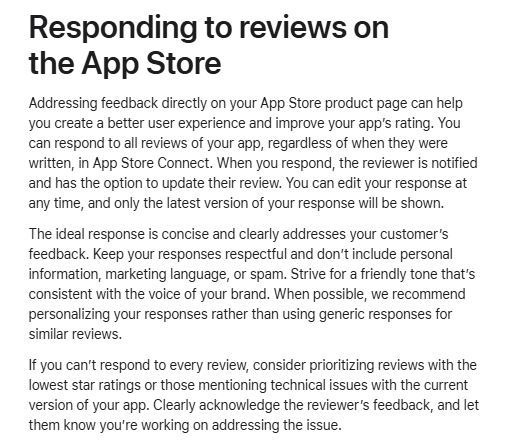
-
Quickly fix issues to improve retention
-
Prioritize urgent issues: If the application crashes or has abnormal functions after iteration, which seriously affect user experience, an emergency repair must be started immediately and a patch version released in time.
-
Focus on retention and activity metrics: User retention rate and activity are the core factors affecting app ranking. Apple and Google platforms tend to rank apps with continuous activity and high user stickiness at the top.
-
Monitor key data metrics: Developers need to use in-app analytics tools to track key metrics such as next-day retention, 7-day retention, and average usage time after updates.
-
In-depth analysis of the reasons for retention decline: If you find that the retention rate has declined, you need to investigate the specific reasons, which may involve new features that are unpopular, user confusion caused by interface changes, performance problems, etc.
-
Targeted optimization of APP experience: After finding the problem, optimize it in time. For example, if users feedback that the new function is complex and difficult to use, simplify the process or add tutorial guidance in the next version; if the crash rate rises, concentrate resources to fix bugs.
-
Continuously improve ratings and reviews: By continuously improving the quality of applications and user experience, reduce user churn, thus ensuring long-term stable application rankings.
-
Use user feedback to optimize APP and ASO
-
Pay attention to the effective information in user Reviews: User feedback contains user preferences and dissatisfaction, developers need to regularly collect and classify, for APP optimization and ASO provide direction.
-
Refine positive feedback to optimize metadata: Extract keywords and core selling points from frequently appearing positive reviews, incorporate commonly used user names and review expressions into the application title or description, enhance the friendliness and authenticity of metadata, and improve conversion effect.
-
Improve the APP experience based on negative feedback: respond to negative feedback in a timely manner, solve problems in a targeted manner, and inform users of improvement content through release notes in the next update, reflecting the developer's emphasis on user needs.
-
Form a positive cycle to help ASO: By continuously using user feedback to optimize the APP, gradually improve the reputation of the application, thereby improving ratings and retention rates, promoting ranking rise, attracting more new users, forming a positive ASO cycle.
In short, user feedback management is a long-term work of ASO. By carefully managing user relationships and improving application ratings and user satisfaction, developers can not only directly improve the ranking performance of applications in stores, but also cultivate loyal users and lay the foundation for the long-term development of applications.
💡 If you still have any questions about user ratings and reviews management, please feel free to contact usAppFast Customer Service. Our ASO experts will provide you with exclusive optimization suggestions for free, helping you solve problems efficiently.
Other optimization suggestions
In addition to the above key areas, there are other optimization measures that can help developers maintain app visibility after iteration:
-
Stay up to date with new features and policies in the App Store
-
Pay attention to the new features and policy updates of app stores: App store platforms continue to launch new features and policies. It is an important prerequisite for ASO optimization to pay attention to and be familiar with these contents.
-
Understand the new tools of mainstream platforms: Apple's App Store has introduced custom product pages, application events and other tools in recent years; Google Play has launched store listing experiments (A/B testing), application event cards and other functions, all of which are effective aids to ASO optimization.
-
Use new tools to improve ASO:
-
For example, with Apple's product page optimization testing tool, multiple sets of screenshots or descriptions can be uploaded simultaneously for A/B testing, and the best version can be selected through data-driven analysis;
-
By creating app events, you can highlight new activities or updated content of the app in a specific time period to attract users to click.
-
-
Compliance with the use of tools to achieve the goal: familiar and reasonable use of official tools, can effectively improve the exposure and conversion rate of the application without violating the platform rules.
-
Optimize app performance and compatibility
-
Clarify the implicit impact of performance and compatibility: The technical performance of applications (such as crash rate, loading speed, device compatibility) does not directly appear on the store page, but it affects user experience and retention, thereby indirectly affecting rankings.
-
Google's explicit correlation rules: Google's Android Vitals will directly link application crash rates, ANR rates and other indicators to search rankings, and applications with poor performance may be reduced in exposure in the Play Store.
-
Apple's potential algorithm logic: Although Apple has not publicly stated, it can be speculated that its ranking algorithm will also consider application stability and user satisfaction.
-
Core optimization actions for developers: Performance optimization of applications should be emphasized, and test tools and monitoring services (such as Crashlytics) should be used to promptly discover and fix problems.
-
Enhance compatibility adaptation: Ensure that the app adapts to the latest OS versions and mainstream devices, reducing negative ratings and uninstallations caused by compatibility issues.
-
Final goal-oriented: Smooth-running, stable and reliable applications are more likely to gain users' long-term favor, thus maintaining an advantage in rankings.
-
Multi-channel Traffic Generation and Promotion
Out-of-store promotion is an important catalyst for ASO visibility. Traffic from social media, content marketing and offline events has a dual value:
-
Direct Conversion Download
-
Increase the relative popularity of the store → Trigger algorithm recommendations
Golden time for promotion of new version:
-
Promotion activities should be launched within 72 hours after the function iteration is online:
-
Tech Blog Analyzes New Features Core Value
-
Reddit/Twitter topic interaction
-
Offline experience will invite KOL to test
-
When the overall download volume and activity of an application increase, the algorithm of the app store is more likely to recommend it to more users, forming a virtuous cycle.
Conclusion
App ranking drop after app iteration is a common challenge, but can be effectively addressed through systematic ASO optimization. The keys to success are:
-
Accurate attribution: Identify algorithm updates, metadata errors, and competitor actions as the core causes
-
3D Battle:
-
Dynamically adjust keywords to respond to search trends
-
Synchronous iteration version optimization metadata correlation
-
Turning User Feedback into Ratings Enhancement Engine
-
-
Continuous Evolution: ASO is not a single task but a full life cycle practice
Mobile ecological iron law: User demand migration × Competitor strategy upgrade × Store rules iteration = Must establish ASO continuous monitoring mechanism
Has your app also experienced a decline in rankings after iteration? Get an exclusive ASO health diagnosis now!
Just 1 minute to submit information, our experts will help you:
✅ Deep analysis of the core reasons for ranking decline (algorithm? Metadata? Competitors? Ratings?)
✅ Identify current keyword performance gaps and optimization opportunities
✅ Provide a customized optimization suggestion report
📊 Get a free diagnosis report >>
Related recommendations
